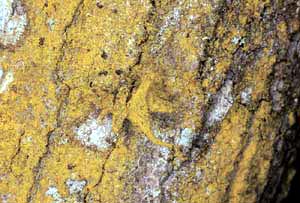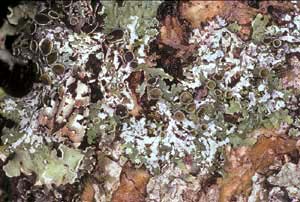Antifreeze, Food and Shelter
Antifreeze
Mosses have a low nutritional value and are usually ignored by the larger animals when other food is available. For example, a reindeer would need to eat 7 kg of moss to get the same energy it can get from half a kilogram of tundra grass. Yet some arctic animals (including reindeer) scoff moss down. Barnacle geese that migrate north to arctic breeding grounds start eating moss as soon as they arrive. These mosses contain high levels of arachidonic acid, which helps cells to keep working at low temperatures. In effect the mosses are supplying the animals with a natural antifreeze compound.
 A male caribou, Rangifer tarandus. |
Food
In the Arctic, lichens are important in the winter diets of reindeer and caribou. The lichens involved have low nutritional values but the lichens help the animals survive winter. After the nuclear reactor accident at Chernobyl in Russia many Scandinavian lichens, including those eaten by reindeer, absorbed large amounts of radioactive elements. As a result many reindeer became highly contaminated and their meat and milk was unfit for consumption by humans.
Other vertebrates known to eat lichens include deer, elk, ibex, gazelles, musk oxen, mountain goats, polar bears, lemmings, voles, tree mice, marmots and squirrels. Invertebrates such as mites, snails, springtails and various caterpillars also eat lichens.
 A dense growth of liverworts and lichens on a leaf from a tropical rainforest. |
Shelter
Lichens and bryophytes provide shelter for many species of invertebrates. A dense carpet of bryophyte or lichen can provide a moist and fairly stable environment. Even in exposed areas, dense bryophyte colonies can protect small invertebrates against desiccation. There are both specialist and non-specialist inhabitants of mosses and lichens. For example some crane-fly larvae have leaf-like appendages on their bodies to make them resemble the moss they live in.
Protection?
The leaves of many tropical plants carry considerable numbers of leafy liverworts or crustose lichens. You might think that anything growing on a leaf would be harmful to the plant. At the very least, less light gets to the leaf surface and this reduces food production by the leaf.
The leafcutter ants of Central America collect leaves from living trees and use them to cultivate fungi. These ants are the most voracious herbivores in tropical Central America. One experiment showed that the ants had a very strong preference for leaves free of lichens and liverworts. Probably the chemicals produced by the liverworts or lichens are in some way harmful to the ants or to their fungus gardens, and so the ants avoid harvesting leaves with liverwort or lichen growths.
![An Australian Government Initiative [logo]](/images/austgovt_brown_90px.gif)



